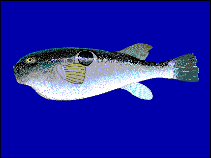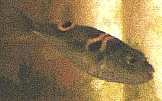  |
  |
 |
 |
 |
 |
| Origin | Japan, China, Korea D P Rep., Korea Rep., Taiwan |
| pH Range | varied |
| Temp. | 50 - 84.2F (10 - 29C) |
| Hardness | varied |
| Salinity | brackish (juvenile) to marine (adult) |
| Length | to 27.5 inches (70 cm) |
| Diet | live, fresh, frozen |
The Japanese
pufferfish, Takifugu rubripes, is found in the open waters and inlets
of areas such as the Seto Inland Sea, west Japan Sea area, east China Sea,
and Japan Sea area. The photos above don't really give credit to its bright
coloration (as most pictures are postmortem). It typically has a
metallic green to blue body, with a bright orange or red spot positioned
just behind and above the pectoral fins.
Perhaps
the most famous pufferfish, T. rubripes is the Japanese puffer used
to make fugu. About 10 species of edible puffers occur in Japan (they
refer to them all as fugu), but this is the species is principally for
farming ventures. Certain parts of the Japanese puffer (and many others)
are extremely poisonous, their toxin some 10,000 times the potency of cyanide.
The toxicity of puffers changes seasonally, becoming the greatest in the
spawning season from May through June. The toxic substance "Tetrodotoxin"
occurs mostly in the ovary, liver, intestines and skin, and rarely in the
muscle. The farming of puffers is generally carried out in the warmer parts
of Japan. I tend to shy away from food that will kill me in just a few
hours.
Takifugu
rubripes is also used as a model vertebrate for genome analysis because
of its small genome size (400 Mb) and high homology with the human
genome.
I haven't
seen this species in an aquarium setting other than that of the restaurateur,
so if you keep this puffer, share your experiences with us below!
Share or read experiences with the fugu puffer [ share ] [ read ]